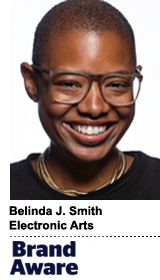
“Brand Aware” explores the data-driven digital ad ecosystem from the marketer’s point of view.
Today’s column is written by Belinda J. Smith, head of global marketing intelligence at Electronic Arts.
I am increasingly running into a widely-held perception that the importance – and influence – of the media director is growing rapidly inside of brands. I’ve read it in articles, heard it in podcasts, seen it at conferences, and have even detected it in the “lucky you” tone in my conversations with others in the industry.
This always makes me laugh because many people who have actually held this job describe the role as not dissimilar to that of a whipping boy.
As a media director, your job is to manage one of your organization’s largest channels and marketing budgets, while navigating one of the most complex landscapes by ensuring you get the right messages to the right customers at the right time for the right price. The media director is responsible for anything from awareness down to revenue growth and customer win-back. It’s an expansive job that covers managing agencies and internal teams and partnering far and wide cross-functionally.
In this role, most of your time can be consumed with proving your value to the brand – because most see media as a cost or expense – and helping your co-workers better understand your function as a tool for growth and long-term investment.
On the side, you are also accountable for being on top of every single thing happening in the media world, from the latest programmatic scandal, to the concerns about agencies, to the movements of walled gardens, the global privacy landscape, fraud, brand safety … the list goes on. You can easily spend most of your time on the defense, explaining why campaigns “cost so much,” the details of this week’s New York Times expose, how full attribution for every dollar spent isn’t the right question – or just working on your complicated romance with the legal, sourcing and finance teams.
Outwardly, many assume it’s never been a more glamorous time to work in media brand-side. With the war for talent, rise of media directors in the public eye and high-profile speeches from Keith Weed or Mark Pritchard, it seems media directors can write their own checks. Yet this narrative ignores the crisis happening inside many brands.
Rishad Tobaccowala recently mused that this crisis started with the ANA report three years ago. You know, the one that got the FBI interested in media.
Rishad noted that the report warned CFOs and CEOs how much of a shit-show our industry is. Execs reading that report took away: (1) the media department has no idea what it’s doing; (2) not only is 50% of our marketing wasted, but the other 50% is likely a mix of fraud, double-dealing or otherwise; (3) digital advertising now carries serious legal and financial risk and must be overseen by compliance; and (4) I should put my media teams and investments under a microscope to ensure we’re making responsible decisions for the company.
If media is having 15 minutes of fame, it’s more like a TMZ video, as opposed to the cover of Forbes.
The better question is what are we going to do with our 15 minutes? We can be along for the ride, or we can be the change. Because the fact is that many of us are evading reality: holding up the shiny new thing as an instant “success,” portraying the brand side as easy and glamorous, and basking in our own glow traveling the conference circuit.
Here are some things I think we should address:
• What is scale? Let’s stop arguing with 100 years of marketing science and just admit that scale grows brands. Targeting is cute, but scale is what matters. Yet how does a brand achieve scale in an age where more than half of the ads we buy are never actually shown to humans, we can’t measure unique reach across our marketing, and audiences are fragmented to a degree never before seen?
• What is my brand’s relationship to data? Let go of data as a crutch and stop perpetuating the dearth of risk, creativity or original thought in our industry because we refuse to do anything that can’t be “proven” with data. We likely do need first-party data, but what do we need it for? I’d make the argument that it’s of way more value for R&D than for ad targeting.
• How to win friends and influence budget? We talk a lot about the tactical elements of the modern brand marketing organization, but there’s almost nothing said about bringing the company along for the ride. This is the most important part to our success. Sure, we can set up in-housing operations, but how do you integrate and anchor that capability so deep within a culture and organization that you don’t find yourself and your team put up for review the same way you used to do to your agency?
These questions are a good start for solving the actual issues we need to be addressing. These are things that are crucial to company and revenue growth. Solving these issues would help our brands succeed, not talking ad nauseum about FANG.
I’d love to hear what else is top of mind for modern brand marketers and where the important discussions are happening. I hope we don’t look back one day (potentially soon) and realize that corporate inertia and keynote speaking killed the media star.
Follow Belinda J. Smith (@BJStech) and AdExchanger (@adexchanger) on Twitter.
This post was syndicated from Ad Exchanger.


More Stories
Citigroup Scales Back DEI Initiatives
Ticker: CBS News Tweaks Format of CBS Evening News
Wednesday, Feb. 19 Evening Cable News Ratings: Jesse Watters Primetime Wins in Adults 25-54